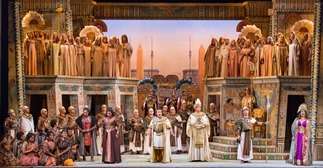|
Back
Sarasota Opera Creates an Electrifying Aida Sarasota
Sarasota Opera
03/15/2016 - & March 19*, 2016
Giuseppe Verdi: Aida
Michelle Johnson (Aida), Leann Sandel-Pantaleo (Amneris), Jonathan Burton (Radamès), Marco Nisticò (Amonasro), Young Bok Kim (Ramfis), Jeffrey Beruan (The King of Egypt), Matthew Vickers (The Messenger)
Sarasota Opera Apprentice and Studio Artists Chorus, Roger L. Bingaman (Chorus Master), Sarasota Opera Orchestra, Victor DeRenzi (Conductor)
Stephanie Sundine (Stage Director), David P. Gordon (Scenic Designer), Howard Tsvi Kaplan (Costume Coordinator), Ken Yunker (Lighting Designer), Miro Magloire (Choreographer)

(© Rod Millington)
For the final operatic production of their 28-year cycle of all Verdi’s music, Sarasota Opera pulled out all the stops. Despite the city’s population of about 60,000 and the county’s of around 300,000, there is a lot of money in this region, and having spent the past week here one became used to seeing a wealthy and highly-educated population participating in the arts. In fact, Sarasota is often cited as the cultural capital of Florida. (The company’s new production of Aida cost a cool $1.5 million.) The dedication and personal touch that Artistic Director Victor DeRenzi and Executive Director Richard Russell and his staff bring to their operation ensure that all details are meticulously realized—from an outstanding young singers development program to an audience development policy that would be hard to beat.
Imagine a Metropolitan Opera production of Aida staged in a house with 1,100 seats. That was the impression given on Friday evening when Sarasota Opera’s production captivated and entranced the audience. But although one of the grandest operas renowned for spectacle, Aida is a work of contrasts, and has as many intimate arias and duets as it has thunderous choruses. These contrasts are played through via complex struggles between hunger for and abandonment of power, love of country and love for the individual, obedience to parental authority and the dictates of one’s heart, and exterior success and intimate peace. The Sarasota production succeeded on all levels.
Visually sumptuous, every aspect seemed to be authentic. The traditional sets by David P. Gordon were decorated with religious symbols awash in myriad colors. No expense was spared on the hundreds of Howard Tsvi Kaplan’s finely-textured costumes, which were often encrusted with hundreds of sparkling gems. The only drawback to the spectacle was the size of the stage which couldn’t accommodate all the Ethiopian plunder at once. Stephanie Sundine’s stage direction flowed effortlessly and she made the best use of the singers’ acting abilities. Joanne Middleton Weaver’s hair and make-up ranged from the subtle to the grandiose. Especially effective were the coiled, or “dreadlocked” headdresses. Ken Yunker’s effective lighting ranged from the brightly lit “triumphal march” to the gloomy tomb in Act IV where one could just make up the grey silhouette of Aida hiding in the cell adjoining that of Ramadès. Miro Magloire’s choreography for the three ballets, with their liquid, broad gestures, took advantage of all the available stage.
Vocally, all soloists were strong. The standout was Michelle Johnson as Aida. Unlike the other principals, who often shouted and sang too loudly, Johnson normally held back, consequently and consistently thrilling the audience with her effortless, long-held high notes, especially in “O patria mia”. Leann Sandel-Pantaleo as Amneris also thrilled with her mesmerizing performance. She displayed wily cunning in Act II when she tricked Aida into revealing her love for Radamès. In Act IV she threw herself into a frenzy over her grief and love for the condemned Ethiopian. If this had been Broadway she could have won a Tony for best actress. Jeffrey Beruan as the king of Egypt also deserves special mention. His smooth, sonorous bass, without a hint of vibrato, brought an aristocratic dignity his role.
The large chorus, prepared by Richard P. Bingaman, sang, even at their most forceful, with one voice and a round, resonant sound. The orchestra, including the four on-stage natural trumpets in B and A flat, conducted by Maestro DeRenzi, provided effortless, solid support. The music would have benefited, however, from a little more judicious use of nuance in tempos and dynamics.
This was a traditional Aida for traditional audiences. But if ever reprised, those who relish spectacle and raw power should run to see it.
Earl Arthur Love
|